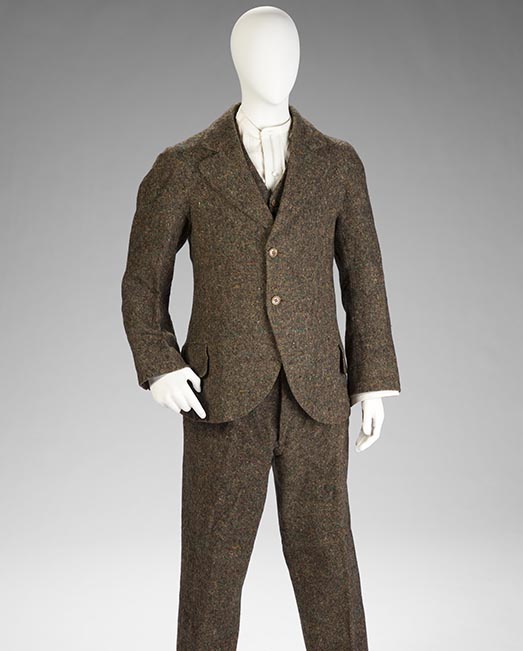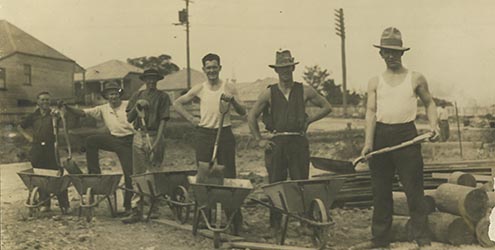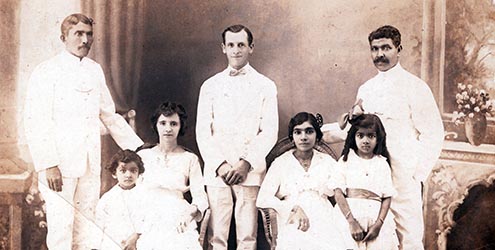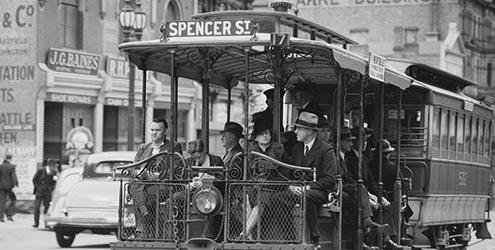Community
Copyright@ Australian Catholic University 1998-2026 | ABN 15 050 192 660 CRICOS registered provider: 00004G | PRV12008
Copyright@ Australian Catholic University 1998-2026 | ABN 15 050 192 660 CRICOS registered provider: 00004G | PRV12008

When Melissa Bellanta was a kid, she was obsessed with clothes. She keenly remembers rummaging through her mother’s wardrobe, searching for old-fashioned items that opened a portal into another time.
“I was fascinated with vintage clothes and I always wanted to dress in an old-fashioned way,” says Dr Bellanta, Associate Professor of Modern History with ACU’s National School of Arts. “It was in many ways a very feminine fascination, but at the same time, I was also drawn to certain items in my dad’s closet.”
This included her father’s collection of velvet clip-on bow ties, and a leather jacket that saved his life when he was in a motorcycle accident.
“As I grew older, I realised that menswear is also a portal into stories about individuals, but in Australia, men’s fashion hasn’t been treated with the same care and fascination that women’s fashion has. That in itself became fascinating to me.”
As a result, Dr Bellanta began to hone-in on men’s dress as a research topic. Since 2019, together with ACU’s Lorinda Cramer, she has been engaged in an Australian Research Council discovery project that will produce the first dedicated history of men’s dress across 20th-century Australia.
Titled Coat Tales: A Social and Cultural History of Australian Menswear, the project has to date yielded around a dozen research papers and media articles and a website, and will also produce a book, symposium and digital exhibition.
“As we’ve presented our findings, the response has very much been, ‘Wow, this isn’t a topic that has been dealt with before, and it’s something that needs to happen’,” says Dr Bellanta, who first began exploring men’s clothing in her book Larrikins: A History, which won the Ernest Scott Prize in 2013.

Labourers in their singlets, 1923. Photo from State Library of Queensland.
“There is so much potential for men’s dress to tell us things about a particular social and cultural moment, and about particular things like gender, sexuality and inequality in Australian society. As a research topic, it is incredibly multi-dimensional, and it’s this multidimensionality that makes it so powerful.”
Lorinda Cramer’s childhood memories are also coloured by an obsession with clothing. As a teenager, she veered between wanting to become an historian and a fashion designer.
“It was such a thrill when I realised that I could converge those two interests into one and become a dress historian,” says Dr Cramer, a research fellow in the Gender and Women’s History Research Centre at ACU’s Institute for Humanities and Social Sciences.
She also remembers rifling through her parents’ wardrobe, her hands connecting with the cloth as she observed the different fibres that were being used at the time. One particularly strong memory was when she came across her father’s football kit, noticing the stains and the residual smell of sweat and deep heat.
“I loved the idea that those clothes told a story about my father,” she says. “It’s such a strong memory for me, and I think that might be what prompted this interest I have in looking at surviving clothes, exploring what the stains, the smells and the evidence of repairs can tell us about the lives of the people who wore them.”
As part of the Coat Tales project, Cramer and Bellanta have incorporated examples of material culture housed in Australian museums. While they’ve been heartened to discover that many museums hold rare examples of men’s clothing in storage, they’ve also been mindful of the limitations of using these collections as a historical source.
“Unfortunately there’s much less men’s clothing than women’s clothing in museum collections, and often what they hold is very narrow in scope,” says Dr Cramer, who has worked as a museum curator and collection manager, and who in 2022 won a prestigious National Library of Australia Fellowship.
“So while it’s been wonderful to explore the opportunities presented in material culture, we’ve had to keep at the back of our minds that what is in museum collections is not quite representative of what men were wearing.”
This challenge has forced the researchers to adapt their methodologies and focus more on alternative sources.

Broome residents in tropical whitewear, 1910. Photo from the Morris Collection, Broome Historical Society.
“Photographic evidence of men’s dress became far more important to us than what we initially anticipated or hoped,” says Dr Bellanta, who points out that working on a topic that is so large in scale has also presented challenges.
“We couldn’t possibly tell a story that says everything there is to say about men’s dress over a course of a century, so the scale has been a major challenge. The minute you start picking on a particular topic, it feels like it’s going to unravel because of how many directions you could take it.”
Among the chief aims of Coal Tales is to challenge the assumption that in Australia, fashion is solely a feminine concern.
Even today, there is a persistent notion that ‘real’ Aussie men are stoic, salt-of-the-earth types who are unconcerned with clothing and appearances.
By investigating trends in Australian menswear, revelling in both striking garments and everyday looks, these historians are uncovering the underlying importance of men’s dress: what the clothes reveal about the men who wore them, and the society they lived in.
Take, for example, the men’s suits that sit at the centre of a journal article titled, ‘Clothes shall mark the man: Wearing suits in wartime Australia, 1939–1945’. The article, published in 2022, investigates the stylish double-breasted suit, the ‘victory suit’, the flamboyant ‘zoot suit’, and the ‘civvy suit’.
Each of these suits “reveal something distinct about men and their relationship to clothing during these years,” Cramer and Bellanta write, “drawing a line between men’s attentiveness to their dress and their concerns, anxieties and desires.”
Even simple and casual pieces of clothing can tell us complex stories. Take the humble singlet, which Lorinda Cramer terms “the uniform of Australia’s working man”.
In 2020, in a Friday essay for The Conversation, she wrote that that singlet-wearing has transformed significantly over time, and that even how one wears their singlet “can be seen as a marker of class”.
“The change that this piece of clothing gone through is fascinating – from underwear to sportswear to outerwear to being worn by rock musicians and gay men at nightclubs,” Dr Cramer says. “It shows us how particular items of dress can become associated with particular moments or particular states of being.”
So, what else will the Coat Tales project bring to light about everyday experiences of gender, sexuality, relationships, culture and social change?
Melissa Bellanta raises “the dream of egalitarianism in Australia”, and how it relates to men’s dress.

Suits on a Melbourne tram, 1940. Photo from the State Library of NSW.
“There’s been this underlying hope or desire that menswear will smooth over inequality and make it possible for everyone to feel like they’re participating,” she says.
“That tells us that the ideal of egalitarianism is a very important value in Australian society, and to some extent it has been realised.
“But as soon as you start thinking about the specificities – take, for example, the experience of many First Nations men, who for so much of the 20th century were unable to afford a decent suit and were forced to wear hand-me-down clothes – you learn an enormous amount about how important class is across Australian post-colonial, post-invasion history.”
Dress therefore serves as a powerful marker of the inequality experienced by certain groups of men in our society, often sustaining inequities of race and class.
Perhaps the biggest challenge of the project, say Bellanta and Cramer, is marrying the individual stories with the broader narrative around men’s shifting clothes and looks over the course of the 20th century; how fashion shapes gender, determines social status, and simultaneously expresses and sculpts identity.
“It’s such a huge project and a multidimensional topic and that can sometimes make it feel challenging and difficult to grasp,” says Dr Bellanta. “But at the same time, it’s the things that make it difficult that also make it so rich and rewarding.”
Keen to find out more about Coat Tales: A Social and Cultural History of Australian Menswear? Explore the website.
Passionate about research? Explore research at ACU.
Copyright@ Australian Catholic University 1998-2026 | ABN 15 050 192 660 CRICOS registered provider: 00004G | PRV12008